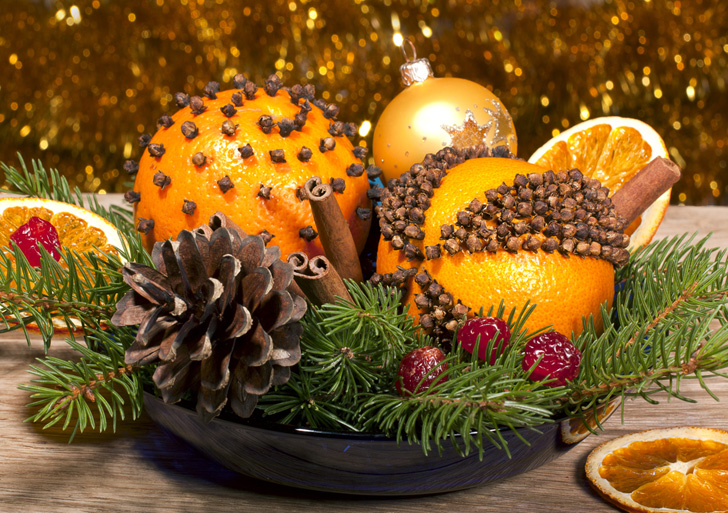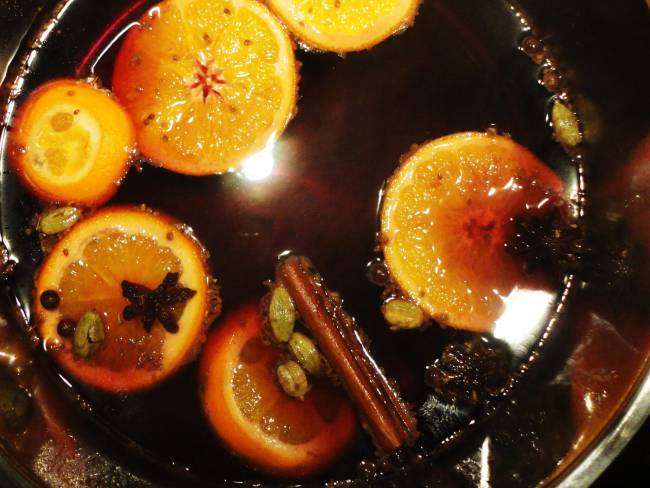 Ah, that distinctive festive aroma is starting to fill the air… that sweet, spicy scent that conjures up everything that is Christmas and creates that special warm and fuzzy feeling in the depth of our bellies.
Ah, that distinctive festive aroma is starting to fill the air… that sweet, spicy scent that conjures up everything that is Christmas and creates that special warm and fuzzy feeling in the depth of our bellies.
What produces that unique Christmas aroma and how can you use these flavours to recreate a famous festive tipple?
The Smells of Christmas
The smell of Christmas today is one of cinnamon, cloves, nutmeg and ginger – four sweet aromatic spices that instantly conjure up Christmas, and are used in a lot of our cooking over the festive period.
Spices have always cast a spell on our imaginations; conjuring up exotic images of colourful, vibrant distant lands.
The first expeditions for spices in ancient times were to ensure that these coveted commodities would always be in supply. Legend has it that in 1000 BC, the Queen of Sheba visited King Solomon in Jerusalem to offer him “120 measures of gold, many spices, and precious stones.” A cupful of cardamom was worth a poor man’s yearly wages, and slaves were bought and sold for a few handfuls of peppercorns.
The Arabs were the first to introduce spices to Europe. Knowing that they controlled a commodity in high demand, they kept their sources a secret and made up amazing tales of the dangers involved in obtaining them.
 In medieval Europe, soldiers returning from the Crusades loaded up their bags with these fragrant foodstuffs; prompting a comeback in the powerful courts of Europe. It was mainly from the Orient, overland via Arabia, the Red Sea, the ports of Venice and Genoa that spices reached Britain. Venetian merchants, strategically located midway between the Levant and Western Europe, became the great middlemen of the spice trade.
In medieval Europe, soldiers returning from the Crusades loaded up their bags with these fragrant foodstuffs; prompting a comeback in the powerful courts of Europe. It was mainly from the Orient, overland via Arabia, the Red Sea, the ports of Venice and Genoa that spices reached Britain. Venetian merchants, strategically located midway between the Levant and Western Europe, became the great middlemen of the spice trade.
Certain spices were worth so much that one of them even became currency: pepper. Forerunners of sugared almonds, some spices were covered in honey in order to disguise them as candy. Their culinary and medicinal uses overlapped, and grocers and apothecaries often worked in the same companies. Besides traditional black pepper, some of the other prized spices of the era were long pepper from Sumatra, ginger, cinnamon, cloves and nutmeg.
It was Vasco Da Gama discovering India in 1498 that led to the downfall of the Arabian/Venetian spice monopoly. The Portuguese held onto it for a century to lose it to the Dutch in the 1600’s.
During this period, British cooking was still heavy with ginger, pepper, cinnamon, cloves and nutmeg. The food of Italy, Portugal, France, Holland and Germany was similarly spiced and scented.
It was not until towards the middle of the seventeenth century that the British East India Company held a monopoly on all trade with India and that the British began developing it’s cooking along the lines that we recognise today. Spices and sugar were readily available and therefore became relatively cheap and available to the everyday cook.
Cinnamon
 Cinnamon is a spice obtained from the inner bark of evergreen trees from the bay family.
Cinnamon is a spice obtained from the inner bark of evergreen trees from the bay family.
It has a complex, fragrant and sweet citrus flavour. Cinnamon’s perfumed aroma is unique but has hints of clove, nutmeg and sandalwood. Cinnamon is commonly used in sweet baking as well as in savoury foods such as curries.
As a medicinal herb, it is antibacterial, antiviral, a circulatory stimulant, an antispasmodic and a digestive. It is used to enhance digestion and given to people for indigestion, nausea, colic and wind. It is also effective in helping to treat gastro-enteritis. More recently it has been found to enhance the effects of insulin; helping to prevent glucose intolerance that can pre-dispose to diabetes. So the perfect spice to add to all those Christmas cakes and mince pies!
Cloves
 Cloves are the dried, unopened flower buds from an evergreen tropical tree, Syzygiumaromaticum. The clove tree is originally a native of the eastern Indonesian islands, called the Moluccas.
Cloves are the dried, unopened flower buds from an evergreen tropical tree, Syzygiumaromaticum. The clove tree is originally a native of the eastern Indonesian islands, called the Moluccas.
The flavour is strongly pungent, while the aroma is somewhat peppery.
Cloves can be used both internally and externally. Internally they can soothe and relax the inner lining of the intestines, aiding in digestion and calming an upset stomach. They can help the esophagus to produce more phlegm and act as an expectorant, making coughs less severe and more productive.
Cloves have also been shown to have analgesic properties. The old wives tale of applying clove oil for toothache is true. A whole clove applied directly to the gum in problem areas or a drop of clove oil rubbed into the gum can help to provide relief from pain.
When the oil is applied topically, it can relieve pain from rheumatism, arthritis, and other inflammation-based conditions.
Nutmeg
 Nutmeg spice comes from the nutmeg tree, Myristicafragrans, which was originally native only to the Moluccas Islands in Indonesia.
Nutmeg spice comes from the nutmeg tree, Myristicafragrans, which was originally native only to the Moluccas Islands in Indonesia.
Nutmeg trees are a tropical evergreen tree that grow some 7-10 meters high and have shiny dark green leaves.
The medicinal use of nutmeg is due to its essential oil, Myristicinwhich, which is used as a stimulant to the intestinal tract, aiding flatulence, and alleviating nausea and vomiting. It is regularly used in mixtures of oils to relieve pain and inflammation and also has antibacterial properties.
However the United Nations Office on Drugs and Crime classes nutmeg as a narcotic. It has a hallucinogenic effect and can induce stupor. The evidence is mainly anecdotal but is considered so frequent as to be overwhelming, “Excessive doses of nutmeg have a narcotic effect; symptoms of delirium and epileptic convulsions appear after 1-6 hours.”
We are talking of dosages being in the region of 1-2 whole nutmegs per person for any harmful effect but maybe it brings a hint of danger to eating our Christmas cake and puddings
Fancy creating your very own home-made mulled wine this Christmas?
Here’s the secret recipe:
Spicy Mulled Wine
 Ingredients
Ingredients
• 2 oranges
• Peel of 1 lemon
• Peel of 1 lime
• 250g demerara sugar
• 12 whole cloves
• 2 cinnamon sticks
• 3 fresh bay leaves
• 6 cardamom pods
• 1 whole nutmeg
• 1 whole vanilla pod, halved
• 2 bottles of red wine
• 120ml Sloe Gin (optional)
Method
1. Peel large sections of peel from your oranges, lemon and lime using a peeler. Put the sugar in a large saucepan over a medium heat, add the pieces of peel and squeeze in the juice from the oranges.
2. Add the cloves, cinnamon stick, bay leaves, cardamom pods and about 1/2 grated of nutmeg. Put in the halved vanilla pod and stir in enough red wine to cover the sugar. Let this simmer so that the sugar has dissolved into the red wine and then bring to the boil. Keep on the boil for about 4 to 5 minutes, or until you have a thick syrup. This infuses the spices and the wine to give a base syrup.
3. When the syrup is ready, turn the heat down to low and add both bottles of wine. Gently heat the wine and after around 5 minutes, when it’s warm, add the sloe gin, ladle it into glasses and serve.
Delicious!
 It’s the most wonderful time of the year! And it’s also the most chaotic! From making sure the house is spick and span ready for those visitors, to mastering the perfect Christmas roast, the festive period can be your back’s worst enemy if you’re not careful! But following these simple tips from our Southend chiropractor can help reduce your risk of picking up a painful back injury this Christmas …
It’s the most wonderful time of the year! And it’s also the most chaotic! From making sure the house is spick and span ready for those visitors, to mastering the perfect Christmas roast, the festive period can be your back’s worst enemy if you’re not careful! But following these simple tips from our Southend chiropractor can help reduce your risk of picking up a painful back injury this Christmas …
 Christmas is next month. Next month! If you’re like our chiropractors here in Southend, you’ll be well into the festive planning by now. But have you got your plans in place to ensure you have a pain-free Christmas?
Christmas is next month. Next month! If you’re like our chiropractors here in Southend, you’ll be well into the festive planning by now. But have you got your plans in place to ensure you have a pain-free Christmas? Ah, that distinctive festive aroma is starting to fill the air… that sweet, spicy scent that conjures up everything that is Christmas and creates that special warm and fuzzy feeling in the depth of our bellies.
Ah, that distinctive festive aroma is starting to fill the air… that sweet, spicy scent that conjures up everything that is Christmas and creates that special warm and fuzzy feeling in the depth of our bellies. In medieval Europe, soldiers returning from the Crusades loaded up their bags with these fragrant foodstuffs; prompting a comeback in the powerful courts of Europe. It was mainly from the Orient, overland via Arabia, the Red Sea, the ports of Venice and Genoa that spices reached Britain. Venetian merchants, strategically located midway between the Levant and Western Europe, became the great middlemen of the spice trade.
In medieval Europe, soldiers returning from the Crusades loaded up their bags with these fragrant foodstuffs; prompting a comeback in the powerful courts of Europe. It was mainly from the Orient, overland via Arabia, the Red Sea, the ports of Venice and Genoa that spices reached Britain. Venetian merchants, strategically located midway between the Levant and Western Europe, became the great middlemen of the spice trade. Cinnamon is a spice obtained from the inner bark of evergreen trees from the bay family.
Cinnamon is a spice obtained from the inner bark of evergreen trees from the bay family. Cloves are the dried, unopened flower buds from an evergreen tropical tree, Syzygiumaromaticum. The clove tree is originally a native of the eastern Indonesian islands, called the Moluccas.
Cloves are the dried, unopened flower buds from an evergreen tropical tree, Syzygiumaromaticum. The clove tree is originally a native of the eastern Indonesian islands, called the Moluccas. Nutmeg spice comes from the nutmeg tree, Myristicafragrans, which was originally native only to the Moluccas Islands in Indonesia.
Nutmeg spice comes from the nutmeg tree, Myristicafragrans, which was originally native only to the Moluccas Islands in Indonesia. Ingredients
Ingredients